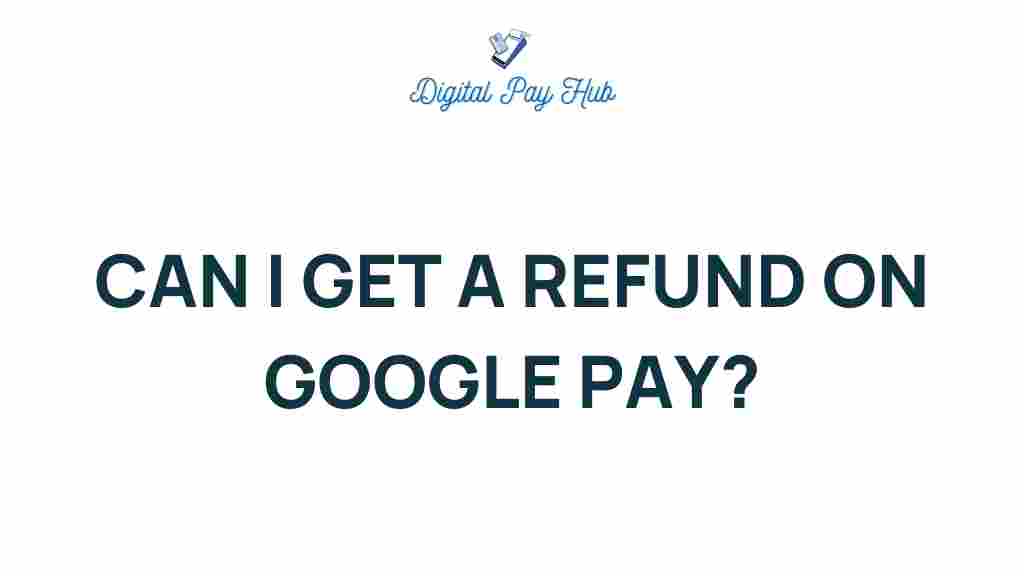Navigating Refunds: Can You Get Your Money Back on Google Pay?
In the fast-paced world of digital transactions, payment apps like Google Pay have revolutionized how we handle money. With the convenience of sending and receiving payments at our fingertips, many users wonder about the potential for refunds should something go awry. Understanding how refunds work on Google Pay is crucial for ensuring financial security and a smooth user experience. This article will guide you through the process of getting your money back on Google Pay, addressing common transaction disputes and providing helpful tips along the way.
Understanding Google Pay and Its Refund Policy
Google Pay is a widely used payment app that allows users to make transactions online, in-store, and to send money to friends and family. Despite its user-friendly interface, there may be instances where you need to request a refund. This could be due to a variety of reasons, including:
- Accidental transactions
- Incorrect payment amounts
- Disputes over goods or services
- Fraudulent transactions
Before diving into the steps for obtaining a refund, it’s important to note that Google Pay itself does not directly handle refunds. Instead, the process varies depending on the merchant or service provider involved in the transaction. Understanding this will help set your expectations while navigating refunds.
Step-by-Step Process for Requesting a Refund on Google Pay
If you find yourself needing a refund after a transaction made through Google Pay, follow these steps:
Step 1: Contact the Merchant
The primary step in resolving a refund issue is to contact the merchant or service provider directly. Most businesses have their own refund policies and customer support channels. Here’s how to approach this:
- Locate your transaction in the Google Pay app.
- Find the contact information for the merchant (often available on their website or in the app).
- Reach out via email or phone to explain your situation and request a refund.
Step 2: Check the Refund Policy
Before contacting customer support, review the merchant’s refund policy. Some businesses might have specific timeframes or conditions under which they issue refunds. Knowing this can help you articulate your request more effectively.
Step 3: Document Everything
Keep records of your transaction and any correspondence with the merchant. This documentation can be crucial if you need to escalate the issue later. Important documents to keep include:
- Transaction receipts
- Emails or chat logs with customer support
- Any relevant screenshots or evidence of the issue
Step 4: Use Google Pay’s Customer Support
If the merchant is unresponsive or refuses to issue a refund, you can escalate the issue to Google Pay’s customer support. Here’s how:
- Open the Google Pay app.
- Navigate to the “Help & Feedback” section.
- Select “Contact us” and follow the prompts to report your issue.
Google Pay’s customer support can assist with transaction disputes and may facilitate communication with the merchant.
Troubleshooting Common Refund Issues
Sometimes, users encounter complications when trying to obtain a refund. Here are some common issues and troubleshooting tips:
Issue 1: Delayed Refund
If your refund is taking longer than expected, consider the following:
- Check the merchant’s refund timeframe as mentioned in their policy.
- Review your bank statement to see if the refund has been processed.
- Contact the merchant again for updates. Sometimes processing delays occur on their end.
Issue 2: Incorrect Amount Refunded
If you receive a partial refund or the wrong amount, take these steps:
- Verify the amount you initially paid.
- Document the refund amount and communicate this with the merchant.
- Request clarification on the refund amount and ask for a correction if necessary.
Issue 3: Transaction Disputes
In cases of fraudulent transactions or disputes over services rendered:
- Report the issue to Google Pay as soon as possible.
- Gather all relevant evidence to support your claim.
- Follow up regularly with Google Pay’s support team for updates.
Financial Security and User Experience with Google Pay
Using Google Pay offers numerous benefits, including enhanced financial security. However, users should remain vigilant and proactive in managing their digital transactions:
- Enable two-factor authentication for added security.
- Regularly monitor your transaction history for unauthorized charges.
- Be cautious when sharing personal information or payment details.
An excellent user experience also hinges on how effectively you can resolve issues like refunds. Understanding the steps and knowing how to contact customer support can significantly enhance your overall experience with Google Pay.
Conclusion: Empowering Yourself with Knowledge
In conclusion, navigating refunds on Google Pay may seem daunting, but with the right knowledge and steps, you can effectively manage your transactions. Remember that the process often begins with the merchant, and maintaining good documentation is key. If necessary, don’t hesitate to reach out to Google Pay’s customer support for assistance in transaction disputes.
By taking proactive measures and understanding the refund process, you can ensure a smooth user experience and maintain financial security in your digital transactions. For more tips on managing digital payments, feel free to check out our payment apps guide.
For further information on Google Pay’s features and policies, you can visit their official website.
This article is in the category Payments and created by DigitalPayHub Team
